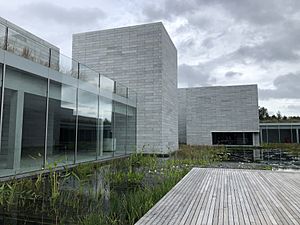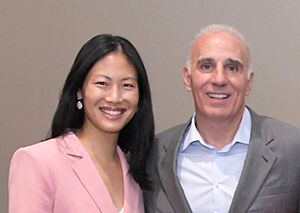Glenstone facts for kids

Pavilions Water Court
|
|
| Established | 2006 |
|---|---|
| Location | Potomac, Maryland, United States |
| Type | Art museum |
| Collections | Contemporary art |
| Collection size | 1,300 |
| Visitors | 100,000 (2022) |
| Founder |
|
| Architect | Charles Gwathmey (2006 building) and Thomas Phifer (2018 expansion) |
| Public transit access | |
Glenstone is a private modern art art museum located in Potomac, Maryland. It was started in 2006 by a wealthy American businessman, Mitchell Rales, and his wife, Emily Wei Rales. The museum shows art from a collection of about 1,300 pieces. These artworks were created by artists from all over the world after World War II.
Glenstone is the largest private museum for modern art in the United States. It is also well-known for its beautiful setting in a large natural area. The first building at Glenstone was designed by Charles Gwathmey. The museum has grown a lot on its 230-acre (about 93-hectare) property. A big expansion finished around 2018. This added outdoor sculptures, new landscaping, a new building complex designed by Thomas Phifer, and an environmental center. Glenstone is often compared to other private museums, like the Frick Collection. The museum is free to visit, and over 100,000 people visited in 2022.
Contents
How Glenstone Started
In 1986, Mitchell Rales bought the land in Potomac, Maryland, to build his home. He started collecting art for his home in 1990. After a serious accident, Rales decided to start a project to help others. This led to him creating a private modern art art museum.
Glenstone is built on land that used to be a fox hunting club. Its name comes from the nearby Glen Road and from stone quarries in the area. The museum is about 15 miles (24 kilometers) from downtown Washington, D.C. The first building, a 30,000-square-foot (about 2,787-square-meter) modern limestone gallery, opened in 2006. At first, it was open to visitors two days a week. In its first seven years, only 10,000 people visited.
Museum Growth and Changes
Glenstone had some smaller expansions after it first opened. However, the biggest expansion was announced in 2013 and finished in 2018. It opened to the public on October 4, 2018. This expansion cost about $219 million. It made the museum's gallery space five times bigger and added 130 acres (about 53 hectares) to the property. There were also many changes to the outdoor areas. With this expansion, Glenstone became the largest private modern art museum in the United States. In 2019, this expansion was named a "Museum Opening of the Year" by Apollo magazine.
After the 2018 expansion, Glenstone became open to the public with free tickets available online. In the year after the expansion, nearly 100,000 people visited the museum.
Since 2018, Glenstone has continued to buy nearby properties. In 2019, curator Emily Wei Rales said that there were no plans for huge expansions. She mentioned possibly adding "one or two smaller buildings to house artworks" and a conservation lab to care for the art.
To help people use public transport, Glenstone worked with Montgomery County to add a bus stop near its campus. The museum lets visitors in without tickets if they arrive by public bus.
In 2021, Mitchell Rales gave $1.9 billion to the Glenstone Foundation. This was made public in 2023. It increased the museum's total value to $4.6 billion. This is almost as much as the Metropolitan Museum of Art in New York.
In July 2021, Glenstone announced a new building. It was specially designed to hold a large sculpture by Richard Serra called Four Rounds: Equal Weight, Unequal Measure (2017). This building was designed by Thomas Phifer, who also designed the Pavilions. It opened in 2022. The museum had over 100,000 visitors in 2022.
The Pavilions buildings were closed from March 2024 to April 2025. This was to replace the special glass used in the buildings.
In June 2024, about half of the museum's staff, who are paid hourly, voted to join a union. They became part of the International Brotherhood of Teamsters Local 639.
Art Collection and Exhibitions

The museum's collection has about 1,300 artworks made after World War II. These include paintings, special art setups by single artists, video installations, sound installations, and both indoor and outdoor sculptures. The collection is worth $1.4 billion. Glenstone only collects works by artists who have been showing their art for at least 15 years.
Many of the museum's large galleries show only one or two pieces of art. They do not have long descriptions next to the art. While some art is always on display, the collection changes over time. Art from Glenstone's collection is also loaned to other public museums.
Glenstone limits how many visitors can come each day to about 600 people. Children under 12 are not allowed. Emily Rales explained that this limit helps visitors have enough time and space to enjoy the museum.
The museum's staff includes recent university graduates. They are part of a two-year program for people who want to become curators. Staff members are in the galleries to answer questions about the art. Visitors are not allowed to use phones or cameras in the galleries.
When the Pavilions expansion opened in 2018, it showed art by Cy Twombly, Robert Gober, Pipilotti Rist, Charles Ray, On Kawara, Martin Puryear, Michael Heizer, Lygia Pape, and Brice Marden. Other artists whose works have been shown at Glenstone include Roni Horn, Alexander Calder, Ruth Asawa, David Hammons, Alighiero Boetti, Kerry James Marshall, Shirin Neshat, Rirkrit Tiravanija, Mark Rothko, Alex Da Corte, and Jenny Holzer.
Museum Design
Glenstone is known for its peaceful natural setting. It has several galleries and other buildings spread out on a large 230-acre (about 93-hectare) wooded property. The museum buildings are in the middle of the property. Visitors walk about one-third of a mile (about 0.5 kilometers) through the grounds to reach the galleries from the parking lots. The founders wanted to create a calm experience. This is why the museum is sometimes called part of the "slow art" movement.
Buildings at Glenstone
The first Glenstone building opened in 2006. It was designed by American architect Charles Gwathmey. This building is a 30,000-square-foot (about 2,787-square-meter) modern limestone structure. It has 9,000 square feet (about 836 square meters) of gallery space.
The 2018 expansion added 50,000 square feet (about 4,645 square meters) of gallery space. This was part of a 204,000-square-foot (about 18,952-square-meter) museum building called the Pavilions. It was designed by American architect Thomas Phifer. Mitchell and Emily Wei Rales were inspired by several famous buildings for its design. These included the Ryoan-ji Zen temple in Japan and the Menil Collection in Texas.
The Pavilions building is made of 6-foot (about 1.8-meter) long precast concrete blocks. These blocks were poured at different times to create varied colors. Even though it is one building, the Pavilions looks like many separate buildings from a distance. It has eleven galleries connected by glass walkways. The windows are made of 30-foot (about 9-meter) tall glass panels. The galleries use a lot of natural light from clerestories, round windows (oculi), and skylights. Emily Rales said they wanted "discrete spaces where you could essentially enter into another world that happens to be an art installation."
The 2018 expansion of Glenstone was praised by critics. In 2020, it won an Architecture Award from the American Institute of Architects.
In 2019, Glenstone opened a 7,200-square-foot (about 669-square-meter) environmental center. This building has exhibits about recycling, composting, and planting new trees (reforestation).
Outdoor Landscape
The Pavilions building is built around the Water Court. This is an 18,000-square-foot (about 1,672-square-meter) water garden. It has thousands of aquatic plants like waterlilies, irises, thalias, cattails, and rushes. The Water Court's design was inspired by a reflecting pool in Italy. One critic wrote that "Art isn't the heart of the Glenstone Museum... water is." Another critic, Sebastian Smee, described the Water Court as a "beautiful sanctuary" that makes you feel "liberated from everyday cares."
The expansion also added 130 acres (about 53 hectares) of land to the campus. This area has many woodlands and wildflower meadows. The landscape architect Peter Walker's firm designed the outdoor spaces. They planted about 8,000 new trees and moved 200 existing trees. They also changed grassy areas into meadows and fixed streams on the property. Glenstone manages its outdoor areas using only organic products. This outdoor space also features large art installations by artists like Jeff Koons, Félix Gonzalez-Torres, Michael Heizer, and Richard Serra.
Images for kids
-
2022 expansion housing a work by Richard Serra









